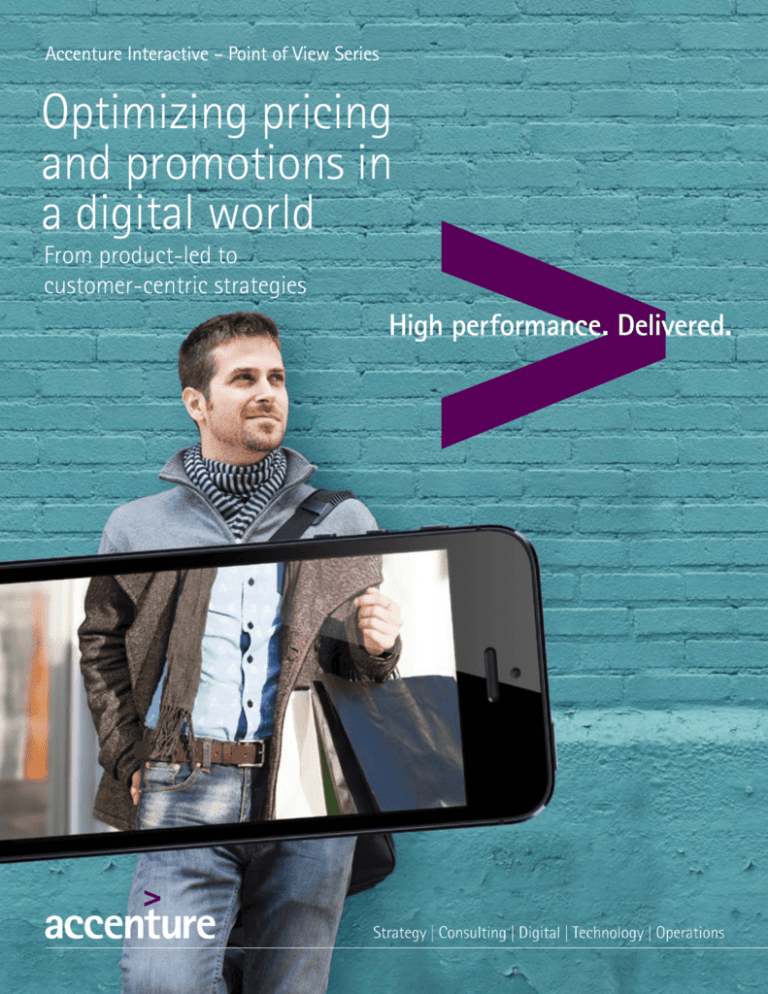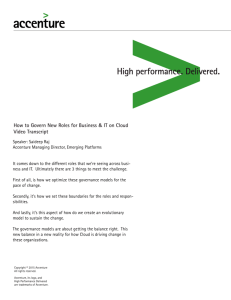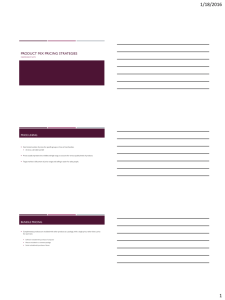
Accenture Interactive – Point of View Series
Optimizing pricing
and promotions in
a digital world
From product-led to
customer-centric strategies
Is the price right?
Today, tech-savvy customers
are actively comparing prices
in-store, online and on the go.
Armed with multiple devices
and looking for the best deal,
consumers are increasingly price
aware, price sensitive and even
price influencers. Companies that
want to succeed in this highly
competitive marketplace should
mirror this ability to actively
compare their prices across all
channels, in real time.
1
Developing and optimizing the appropriate
pricing and promotions strategy is a complex
proposition—hard to get right, but rewarding
for those that do. Using advanced analytics
technologies to understand buyer behavior,
companies can provide more compelling
offers and product pricing to the customer.
The result? Increased sales and profit
margins. Knowing which pricing strategy
to adopt, when, and why, helps companies
to develop relevant promotions, boosting
consumer engagement and customer loyalty.
A Forrester Consulting Thought Leadership Paper Commissioned By Accenture and hybris, an SAP company,
“Customer Desires Vs. Retailer Capabilities: Minding The Omni-Channel Commerce Gap,” January 2014.
71%
Omni-channel retail is fast becoming
the norm: 71% of consumers expect
to view in-store inventory online,
while 50% expect to buy online
and pick up in store.1
A customer-led market
With omni-channel shoppers able to research product offers, compare competitor
deals and even influence the price, traditional sales strategies need to give way to new
customer-centric pricing models.2 This requires unlocking customer data often trapped in
siloed enterprise systems. Investments in big data infrastructure and advanced analytics
are needed to replace manual, labor intensive and time consuming spreadsheets with
automated personalized pricing in real time.
Dynamic customer journey
Competitive price and convenience continues to drive omni-channel customers
who move between channels with relative ease.
Take Jo, who wants to buy a dress for an upcoming celebration. She is looking for
quality at an affordable price. As she begins her search online, comparing prices and
reading reviews on social media sites, one retailer provides Jo with a personalized
promotion: 25 percent discount on a dress she likes and another 25 percent if she
registers as a member. 50 percent discount? Jo likes that deal. But, before taking
action, she decides to visit the retailer’s store in her neighborhood to try the dress on.
Jo is pleased to see that the online and in-store prices and discounts are the same.
She registers in store and purchases the dress she saw online. In the face of such
varied options, how do businesses decide on their pricing strategy? Should prices
and promotions be the same across all channels or differentiated by customer
or product?
Mobile
Social
In-store
Online
2
Ibid
Pricing strategy options
Companies can adopt a number of
possible pricing strategies, depending
on their customer base, offering and
the market dynamics. Broadly speaking
pricing strategies can fall under one of
the following three options:
1. Channel specific:
2. Omni-channel:
Prices are channel and product-centric;
not shopper-centric. This strategy assumes
that certain segments of customers tend
to shop specifically through one channel.
Customers who go online would not visit a
store and vice versa. To serve both segments,
businesses can have one price for online and
another one for in-store.
Prices are shopper-centric and the same
across all channels. This strategy aims to
build trust and loyalty among price sensitive
customers, who have a tendency to compare
prices across a number of channels before
making a purchase. This strategy becomes an
even more important part of the customer
journey for companies where a high
proportion of their sales are made online.
3. Hybrid:
10%
While prices are the same across all channels,
there are exceptions depending on the
situation. This strategy combines the benefits
of a single price across channels, with timesensitive promotions aimed at a particular
audience through a specific channel, for
example an online ‘back-to-school’ promotion
or in-store overstock sale. For those customers
that compare prices, the company offers
to match the promotional price across all
channels, and allows coupons offered in one
channel to be redeemed in any other channel.
Whatever pricing strategy is adopted, there
is significant competitive advantage in
leveraging advanced analytics to answer
tough questions about customer behavior.
This, in turn, helps businesses to adapt each
model to the market dynamics and the price
customers are willing to pay.
Gaining insight into buying
behavior across channels
When developing pricing strategies and
designing promotions, it is important to
have insight into the buying behavior of
customers and anticipate their response
to the pricing models by asking a number
of strategic questions. How prevalent is a
business’s digital channel in the customer
journey? Will price variation across
channels lead to greater profitability? If
prices are allowed to vary across channels,
will that slow down the customer’s
decision-making process?
3
5
Ibid
1
When designing, building and optimizing
the appropriate pricing and promotions
strategy, the following five factors should be
taken into account:
2
Channel profitability:
to understand if a pricing
and promotions strategy will
be worth the investment,
optimizing spend and improving
return on investment.
Consumer response:
to know if the demand for a product will increase or
decrease when a specific pricing option is implemented,
and how this differs across channels. A deeper
understanding of shopper behavior prior to making a
pricing decision will help ensure the most appropriate
strategy is selected to increase sales and reduce costs.
Delivery options:
to understand the cost of free delivery or the consequences
of charging for delivery and help make informed decisions to
maximize return on investment.
When comparing identical
products (at the same price)
between online retailers,
75% of consumers said
that the availability of free,
expedited shipping will sway
their purchase decision.3
3
Advanced analytics tools and capabilities are
critical to helping companies gain insights
into price sensitivity and buying behavior.
The potential benefits are clear—satisfied
customers and increased transactions.
75%
Scope and scale:
to determine which locations
(national or local) and channels (online
or offline) should be given preference over
others. Offering the appropriate price to
the right shoppers at the right time
and in the right place, will better
position companies to win lifetime
loyalty and share
of wallet.
4
Competitor pricing:
to determine if and when it
makes business sense to match
competitor prices, and how to
respond to their price changes.
This avoids unnecessary price
matches, diluting product margin
and dragging the whole market
to a price war.
Managing complexity
Restructuring the existing pricing strategy
could impact many aspects of an enterprise
and increase complexity throughout the
business. The following are important
success factors for getting the appropriate
omni-channel pricing and promotions
strategy, reducing risk and managing the
transformation journey:
Data management:
A solid technology foundation is required
for executing a specific pricing and
promotions strategy. Investing in a big data
infrastructure and an advanced analytics
platform will help capture, filter, mine and
access customer transactions and loyalty
data, together with performance metrics
and cost accounting data.
Advanced analytical methods:
A quantitative and qualitative analysis of
customers is crucial for understanding how
they are responding to a particular pricing
model. Such analysis helps gain insight into
why, for instance, certain products are doing
better than others, or specific customer
segments are not interested even when
discounts are offered. A comparative analysis
across channels (in terms of price and
the value generated by promotions) helps
companies understand where they stand
versus their competitors, and how
to respond to them.
Technology:
Using advanced optimization software,
businesses need to implement a new
pricing and promotions strategy across
multiple systems, including legacy. This
requires capability in numerous areas
including developing and implementing
price consistency and transparency,
real-time reporting and analysis on price
and promotions, enhanced competitive
intelligence across channels, and
dynamic pricing options.
Strategic insight:
Innovation in hardware and software
technologies has significantly increased
the ability to gather and store data. But,
unless that data is analyzed and converted
into crisp and actionable insights, it
cannot support business decisions or
motivate decision makers to act.
Attracting, developing and retaining
people with advanced analytics skills
can be challenging.
Continuous test and learn:
This is crucial for understanding customer
preferences and serving omni-channel
customers. As they move from one channel
to another, companies can test new prices,
measure customer responses in real time
and optimize their pricing and promotions
accordingly. In online and mobile channels,
there are opportunities to deploy real-time
multi-variate testing tools to further test,
refine and optimize pricing and
promotional decisions.
The business value of these critical success
factors is vast. Without actionable insights,
a company can spend millions on tools and
analytics that are irrelevant or answer the
wrong business questions. When pricing
insights are incorporated into daily business
processes, strategy decisions can be taken
with confidence. To get the true value
from analytical insight, companies need
to have robust governance and execution
plans in place. The resulting ‘test and learn’
environment helps deliver significant
benefits to both the business and shoppers.
Achieving customer centricity
with pricing analytics
Based on internal research, a leading
European food retailer adopted
multi-channel pricing with a key lines strategy
for online and offline products. However
in the face of stiff competition in the food
industry, where each company is vying to
serve the omni-channel customer, the retailer
was looking for stronger business results. A
pricing strategy based on advanced analytics
was recommended as a possible solution.
Using a sophisticated modelling approach to
understand consumer purchase behavior by
channel, the company gained insight into the
base price sensitivity for a number of products
at a granular level. The company created
and implemented a pricing model based on
product category, position in the basket, brand
and level of elasticity across channels. This
helped stimulate the volume and sales by
channel. The analytics revealed that
customers were more price-sensitive
to products online than in-store. It also
highlighted the fact that the products
considered important in-store did not
have the same impact in the online world.
The new pricing model helped the retailer
move from one set of key lines to a multiple,
more customer-centric and automated set
of key lines. This approach allowed products
to move in and out of the key lines based on
market dynamics. Using an analytics-based
pricing strategy, the retailer was able to
increase the frequency of price updates in
real time and gain a better understanding of
the competition. The impact was a significant
increase in sales and profit, and improved
price perception among customers.
Customer-centric pricing
Omni-channel customers are looking for
relevant and compelling deals. Companies
that can offer personalized and dynamic
pricing, at scale, have a competitive
advantage in the marketplace. In harnessing
the potential of big data and advanced
analytics, companies are able to determine
the price that meets customer expectations
and deliver tailored promotions wherever,
whenever. As the distinction between the
digital and physical world blurs, pricing
analytics will no longer be optional. It is an
essential capability for driving the marketing
and business agenda, and achieving
exceptional growth.
4
Accenture 2013 How Seamless Are You?
Increasingly, consumers desire personalized
experiences through every engagement
channel – tailored to their needs and
preferences: 55% would like to receive
unique pricing, automatic discounts, free
returns, or pre-sales based on loyalty /
purchase history and 53% would like to
earn and use their loyalty rewards in-store,
online or on a mobile device.4
-10 %
e
sal
To learn more about optimizing omni-channel
pricing and promotions, contact:
Conor McGovern
conor.mcgovern@accenture.com
Anthony Levesanos
anthony.levesanos@accenture.com
About Accenture Interactive
Accenture Interactive helps the world’s leading brands delight their customers
and drive superior marketing performance across the full multichannel customer
experience. As part of Accenture Digital, Accenture Interactive works with over
23,000 Accenture professionals dedicated to serving marketing and digital clients
to offer integrated, industrialized and industry-driven digital transformation and
marketing services. Follow @AccentureSocial or visit accenture.com/interactive.
About Accenture
Accenture is a global management consulting, technology services and
outsourcing company, with more than 293,000 people serving clients in
more than 120 countries. Combining unparalleled experience, comprehensive
capabilities across all industries and business functions, and extensive research
on the world’s most successful companies, Accenture collaborates with clients to
help them become high-performance businesses and governments. The company
generated net revenues of US$28.6 billion for the fiscal year ended Aug. 31, 2013.
Its home page is www.accenture.com.
Copyright © 2014 Accenture
All rights reserved.
Accenture, its logo, and
High Performance Delivered
are trademarks of Accenture.
This document makes descriptive reference to trademarks that may be owned by others. The use of such trademarks herein is not an assertion of ownership of such
trademarks by Accenture and is not intended to represent or imply the existence of an association between Accenture and the lawful owners of such trademarks.
Information regarding third-party products, services and organizations was obtained from publicly available sources, and Accenture cannot confirm the accuracy
or reliability of such sources or information. Its inclusion does not imply an endorsement by or of any third party.
The views and opinions in this article should not be viewed as professional advice with respect to your business.







